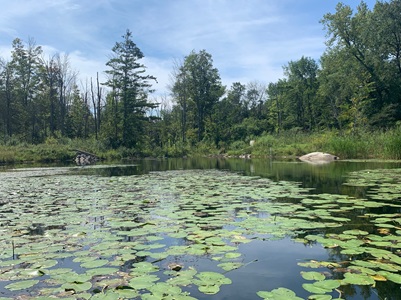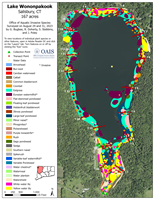
Lake Wononpakook, Salisbury - 2023
Lake Wononpakook (also known as Long Pond) is a 167-acre waterbody in Salisbury, CT. The lake is south of Lake Wononskopomuc and within the Housatonic River watershed. A public boat launch is located off Long Pond Road at the southern end of the lake. Besides a children’s camp and a few houses at the north end, the lake shore is forested and undeveloped. Lake Wononpakook is relatively shallow with a maximum depth of about 35 feet and an average depth of about 10 feet. This creates an extensive littoral zone capable of supporting luxuriant aquatic vegetation.
The Office of Aquatic Invasive Species (OAIS) conducted a vegetation and water chemistry survey of the lake on August 29 and 31, 2023. The vegetation survey documented a diverse aquatic plant community with 27 in-water species and three shoreline species. Cattail, phragmites, and purple loosestrife comprised shoreline species. Phragmites and purple loosestrife are non-native invasives. Of the 27 in-water plant species, 22 are native and five are non-native, invasive species. The five invasive species include curlyleaf pondweed, Eurasian watermilfoil, minor naiad, variable-leaf watermilfoil, and water chestnut. Of these, Eurasian watermilfoil is the most abundant and is found throughout the lake. Minor naiad occurs sporadically around the lake and patches of water chestnut are located at the southern tip and the northeastern side of the lake. Variable-leaf watermilfoil was the least abundant invasive species and only occurs at the very southern tip of the lake in a couple of small patches. Although it is not included on the survey map, curlyleaf pondweed turions were found floating at transect 1 point 10. Curlyleaf pondweed plants were not observed, likely because it senesces mid-summer. A June survey is recommended to document the abundance of curlyleaf pondweed in the lake.
Of the native aquatic plant species, eelgrass and large-leaf pondweed were most abundant and were spread throughout the lake. There were four native, emersed species including white water lily, yellow water lily, watershield, and watermeal. White and yellow water lily was mostly found in the southern and northern parts of the lake. Watershield was only found in the southern part of the lake and is not as abundant as the lilies. Watermeal was found near the boat ramp and transect eight. The least abundant native, aquatic plants were hiddenfruit bladderwort, arrowhead, watermeal, water plantain, a rush species, and a sedge species. Information on managing nuisance vegetation in Lake Wononpakook can be obtained by contacting OAIS https://portal.ct.gov/CAES/OAIS/Contact-Us .
Water clarity on the date of this survey was 7 feet (Secchi measurement) being limited by the water’s tea color caused by natural organic exudates. Lake Wononpakook is very alkaline with a concentration of 178 mg/L (CaCO3) near the surface and 303 mg/L (CaCO3) at the bottom. Phosphorus (P) concentration was 21 µg/L near the surface and 303 µg/L at the bottom. This indicates a moderately fertile condition at the surface (mesotrophic) with P accumulating near the bottom during summer stratification. The thermocline occurred at a depth of about 15 feet with highly oxygenated water above and poorly oxygenated water below.
|
Species recorded in the 2023 survey of Lake Wononpakook. |
|||
| Arrowhead | Eurasian watermilfoil* |
Pickerelweed | Variable-leaf watermilfoil* |
| Bur-reed | Flat-stemmed pondweed |
Purple loosestrife* | Water chestnut* |
| Canadian waterweed |
Floating-leaf pondweed |
Rush |
Watermeal |
| Cattail | Hiddenfruit bladderwort |
Sago pondweed |
Water plantain |
| Illinois pondweed |
Sedge |
Watershield | |
| Coontail | Large-leaf pondweed |
Southern naiad |
White water lily |
| Curlyleaf pondweed* |
Minor naiad* |
Spikerush |
Yellow water lily |
| Eelgrass | Phragmites* | Variable pondweed | |


